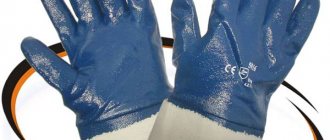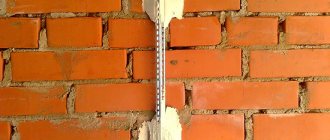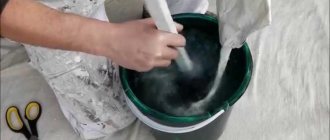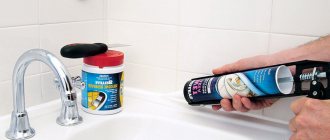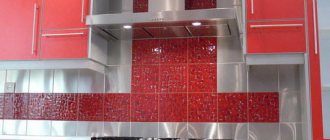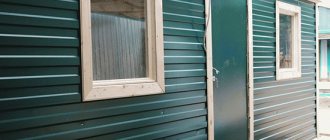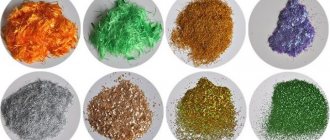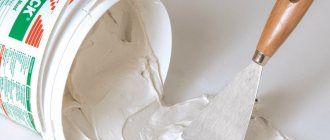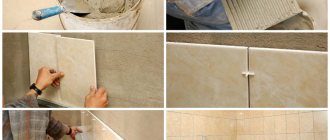The choice of lime for whitewashing walls is due to the fact that this coating has antiseptic properties and does not deprive the surface of its ability to breathe. Whitewashing is quite simple without the involvement of a specialist, and the material is quite easy to work with. Lime whitewashing of walls allows you not to worry about the formation of fungus or mold. The only nuance that should be taken into account is the preparation of the composition in compliance with all the nuances. The most popular is considered to be fluff. It is a white powder that has undergone a quenching process and requires the addition of liquid and various fixatives before application. Lime is sold in two versions - slaked, in the form of a dough (paste) or powder, quicklime, produced in the form of small or large lumps, as well as granules. The latter variety cannot be used for whitewashing. And if only this is available, the mixture is first extinguished. Quicklime is used as an additive in plaster and cement mixtures to improve plasticity properties and bind the components together.
Safety precautions when slaking lime at home
Quicklime and the process of slaking it pose a threat to human health.
The interaction between calcium oxide and water is characterized by a violent reaction: a lot of heat is released, the water boils, and the mixture begins to splash in all directions. Before extinguishing lime, it is necessary to protect the skin, mucous membranes of the eyes and mouth, and protect the respiratory tract. To avoid burns, wear safety glasses, rubber gloves and long sleeves.
The procedure cannot be carried out in a room with closed windows and doors. If it is not possible to check the room, you should use a respirator or gauze bandage. To avoid getting burned by the steam, it is best not to lean over the container.
Preparation
Before you slak the lime, you need to buy quicklime in the store. Most often it is sold in the form of lumps (large or small) or powder. The fraction is not critical for the quenching process.
Related article:
Sending the country house for the winter: 5 stages of preparing a country house for winter
To work, you will also need a deep saucepan or other metal utensils with high sides. Plastic will not work: upon contact with water, the substance heats up to 150-180 degrees, and the plastic will simply melt. It is also necessary to take into account that during the chemical reaction the raw material increases in volume, splashes and bubbles: for a successful process, a reserve of space in the working container will be required.
To properly extinguish lime, you will have to prepare cold water at the rate of 1 liter of liquid per 1 kg. If a solution for whitewashing trees is required, the amount of liquid is increased to 2-3 liters. In summer, it is advisable to use water from a well or borehole. If this is not possible, the liquid is first kept in the refrigerator (for small volumes) or placed in containers in the cellar for 3-5 hours.
Related article:
How to use sawdust in the garden
It is necessary to extinguish lime, observing safety precautions. Since a lot of heat is generated during the chemical reaction, you need to prepare protective clothing and materials that allow you to control the process without harm to yourself:
- thick trousers, raincoat, boots, gloves;
- face mask or respirator, eye glasses;
- wooden stick for mixing raw materials.
When all materials are available, you can begin the process.
Subtleties of use
The product is also effective when carrying out repairs, for example, for whitewashing walls. In these cases, a hydrator is often used for slaking - a device for automated slaking of lime and producing hydrated lime (fluff). The required composition is prepared in advance, a day or two before the main operations. In order to obtain rich and light tones of diluted fluff, the proportion is 1: 1. A thoroughly mixed solution is applied to the material with a brush or using a sprayer in 2-3 layers.
Fluff is often added to various formulations. So, added to cement, it forms a viscous consistency that does not crack even after drying.
Lime is a caustic substance, so when working with it, it is important to adhere to safety measures:
- work in special glasses and gloves;
- during the extinguishing process, you should stay away from the container where the reaction is taking place, since the latter proceeds so actively that you can get burned from flying splashes;
- protect the respiratory system with a cotton-gauze mask;
- in case of contact with the skin, it is necessary to remove the drops with cotton wool soaked in vegetable oil, and place a compress of gauze pre-treated with 5% vinegar on the injured area;
- If the mixture gets into your eyes, rinse them immediately with water and, if necessary, go to the doctor.
How to quench lime for whitewashing - concepts
First, let's understand the concepts, since several compositions are obtained from quicklime, different in consistency and used for different purposes. Most likely, the quicklime will reach you in the form of small or large lumps - this is the result of firing the limestone stone. It is called quicklime because the chemical reaction that forms the same lime for whitewashing trees or painting walls has not yet completed. There is only one correct way to bring quicklime (calcium oxide) to condition (calcium hydroxide or calcium hydroxide) - add water to it. Don’t be afraid, there won’t be a fire, but upon contact with ordinary H2O, a rather violent reaction occurs, releasing a large amount of heat and carbon dioxide, which is why the process got its name.
As a result of slaking lime with water in a 1:1 ratio, fluff is obtained.
This is the main material that is suitable for all purposes: preparing lime mortar, obtaining a solution for whitewashing, for coating wooden elements (saves from rotting and fire), and so on. When more water is added, a lime dough is formed, although the consistency is more like thick sour cream. By diluting it with even more water, we get lime milk. When quenching, you can go straight to one form or another by calculating the correct ratio of liquid to quicklime.
Safety precautions when obtaining a pure mixture
Small particles of lime easily rise into the air and therefore penetrate the respiratory tract. Due to the high humidity of the mucous membranes, the material begins to be extinguished directly in the body.
When extinguishing, a drop of lime can cause severe burns, so you need to adhere to safety precautions:
- respiratory protection. To do this, you need to ensure good ventilation; it is better to extinguish outdoors. A respirator or at least a dust-proof bandage is applied to the mouth and nose;
- protection of the skin and mucous membranes. To work with lime, you need to use elbow-length rubber gloves, as well as safety glasses, and clothing should cover your entire body.
Kinds
There are two types of lime, which are distinguished by the amount of calcium silicates and aluminoferrites they contain: air and hydraulic. They perform various functions, for example, air accelerates the hardening process of concrete, and hydraulic accelerates reactions in water.
It is important that all fragments of the substance are the same size. This moment indicates that the raw material has been completely calcined in the oven.
If pieces are too large or too small, they may not be completely heat treated, and this will reduce the quality of the finished material.
Based on the type of processing, there are several types of material:
- quicklime lump (boiling liquid);
- quicklime ground (powdered);
- quenched hydrate – Ca (OH) 2;
- lime dough;
- lime milk.
Lump lime
Lump lime is a mixture of lumps that differ in size. It contains calcium oxide and magnesium, as well as materials such as calcium carbonate, aluminates, and silicates. Magnesium or calcium ferrites, which are formed during firing of raw materials, can be added.
The good strength of concrete is ensured due to the fact that lump lime requires very little water (due to the fine grinding of the material) and produces virtually no waste.
Ground lime
Ground lime has the same composition as lump lime, but the difference is that the lumps of raw materials are ground much stronger and more thoroughly.
The main advantages of ground lime:
- strength;
- water resistance;
- fast hardening.
To increase or decrease the hardening rate, calcium chloride or sulfuric acid is often used (gypsum material is also suitable).
Hydrated lime
Hydrated lime (also called fluff) is a slaked type of material with a highly dispersed composition. Slaking occurs by adding water to the lime raw material. To prepare such a solution, add from 70 to 100% water to the powder.
In order for the lime to completely go through the slaking process, it must be placed in a special pit for 2-3 weeks. This way it will gain optimal strength and ductility. The minimum cancellation period is 36 hours. To prevent the raw material from burning out, it is advisable to add water gradually until steam stops being released.
Lime paste is formed when sufficient water is added to form a plastic material. You can also find a solution such as lime milk (mainly used for whitewashing tree trunks). Lime milk is made by adding excess water to lime dough.
Types of lime according to slaking speed
The division comes in three groups. The time is calculated from the moment of connection with water until the process of thermal extinction. The division is:
- fast-extinguishing - 7-10 minutes;
- medium-extinguishing - 15-20 minutes;
- slow-extinguishing - more than 25 minutes.
How to work correctly with each variety.
- fast-extinguishing.
Fill half the container with lime and fill it with water to the brim. When steam appears, the lumps will begin to crumble. Now the contents should be carefully mixed with a wooden spatula and a little more water added. After finishing quenching, continue diluting with water until smooth. Then pour everything into the prepared container.
- medium-extinguishing.
Exactly the same as in the first case, fill the lime with water in a ratio of 1/1. The pieces will begin to crumble, but do not stop; continue slaking until a homogeneous mass is obtained.
- slowly extinguishing.
Fill a little more than half the container with lumps of lime and pour little by little from the kettle onto them. After cracks appear on the pieces and extinguishing begins, add water in very small portions. Having obtained a lime “dough” as a result, mix it thoroughly and carefully.
Unfortunately, not all pieces crumble, turning into the desired mass. There are unburnt and burnt lumps. The best solution would be to simply throw them away. During this process, called hydration, it is important that no calcium or magnesium oxides remain. If they remain, the quality of building mixtures will sharply decrease.
During hydration, calcium and magnesium oxides become hydrates, hence the name. In this case, a significant release of thermal energy occurs, the temperature at which reaches 150 degrees. The lump lime is loosened by steam, turning into powder.
How to slak lime: tips and tools
When quicklime reacts with a small amount of water, lime paste is obtained, to which sand and other materials are added. The resulting substance is used in construction to hold bricks together as a binder.
If the mass is diluted with a large amount of water, you get a lime suspension or milk of lime. In agriculture, the suspension is used to treat the bark of fruit trees against sunburn and to destroy the embryos of parasitic organisms that cause diseases. The solution mixed with other substances is also sprayed on fruit trees and shrubs, and whitewashed borders and building walls.
To extinguish lime, do not forget about safety precautions and follow these tips:
- During slaking, lime releases heat. To prevent the container from melting, use enamel cookware.
- The fumes released are toxic to the body and can also cause atrophy of the respiratory tract, so wear a respirator.
- When slaking lime, an ebullient reaction occurs, accompanied by splashing of the substance. To avoid burns, use goggles, rubber gloves and work clothes that cover exposed areas of the body.
- Suppress lime outdoors. If there are windows in the room, open them to create conditions for ventilation.
- During the procedure, stay away from the container until steaming ends.
- When preparing the substance, use a wooden spatula.
The method of extinguishing depends on the purpose of use.
During this procedure, lime paste is used. It is obtained by mixing lump lime with tap water.
The solution is prepared in a ratio of 1:4. Water is added in small, even portions. After the rapid boiling stops, the substance should be stirred well and filtered. After 1 hour, the solution should be left in a dark room for 1–2 weeks.
To whiten trees, a lime slurry is prepared. For this purpose, lime dough is diluted with water. For 1 kg of lime take 10 liters of water. The solution is used immediately.
When slaking lime, the following tools are used:
- enamel container;
- wooden spatula;
- bucket or watering can for water.
Make sure that during the extinguishing process there are no lumps left and the substance of the ball is homogeneous. You can use a sprayer to treat walls, trees, and shrubs. In this case, do not forget to wear a respirator.
Lime mortar: use, composition, preparation
Foundation, strengthening walls, cladding: lime mortar is needed everywhere. This is one of the most common universal mixtures, which is used in the construction industry for leveling walls with plaster.
The use of the solution in question, subject to the technological process, has a positive effect on the durability and quality of the repair.
Today we will look at how the lime mass is prepared. Let's decide on astringent additives and fillers. We will find out the estimated cost and give you a number of useful tips.
Where is lime plaster used?
The ready-made composition of lime mortar for plaster includes, as the name implies, a lime mixture.
Ready-made lime mortar is used for external and internal work in residential premises, industrial and public buildings.
Activities for plastering walls with lime mortar are carried out strictly in accordance with building codes and regulations (SNiP).
Deviation from generally accepted regulations is a violation of the technological process, which may subsequently lead to surface defects.
How to prepare lime mortar for plaster
The preparation of lime mortar for plaster is carried out in stages. One of the stages is slaking of hydrated lime.
It is realized in lumps, so its extinguishing is a prerequisite for preparing the plaster “dough”.
Note!
The full slaking cycle of lump lime is 36 hours. But, to complete the preparatory process, it needs to stand. This is 14 days.
When considering the question of how to slak lime for plaster, it should be noted that the process is accompanied by a violent chemical reaction. Heat is generated abundantly. Consequently, safety rules, which have not yet been canceled, come first.
When preparing the composition and observing the proportions, it is necessary to use personal protective equipment:
- Boots.
- Latex gloves.
- Clothes made from thick fabric.
- Protective glasses.
To prepare the lime mass you will need:
- Metal container for extinguishing. Important! No signs of corrosion.
- You can also use wooden or plastic containers.
On a note.
When slaked, lime increases in volume by approximately 3 times. Therefore, when choosing dishes, it is necessary to take this factor into account.
You should know the ratio of the amount of water used (necessarily cold) and hydrated lime:
- Lime milk (fluff): ratio 1 kilogram per 1 liter of cold water.
- Dough: for 1 kilogram of dough you need 0.5 liters of cold water.
Sequence of steps for preparing lime mass:
- Lime in lumps is placed in a pre-prepared container.
- Add cold water.
- A chemical reaction occurs: the boiling process begins.
- After its completion, the mass must be thoroughly mixed several times and allowed to stand.
Fillers and binders
The density of the solution may vary. This largely depends on the use of fillers and binders. The main types of lime mass fillers include:
- gypsum;
- cement;
- clay;
- sand.
Let's look at their features and characteristics.
Gypsum
Gypsum composition is used for plastering cornice areas where wood or stone is used. Make small portions of the solution so they can be used quickly. Gypsum tends to harden quickly. It is important to remember that the finished gypsum-based mixture practically does not shrink.
Cement
This is the most used material in the mortar for plastering walls on the outside and inside. Cement-lime mortar is used in rooms with high humidity: saunas, basements, technical rooms, and so on. The most common brand of cement for preparing working lime mixture: M-400. It should be taken into account that the finished (treated wall) dries in natural conditions for 30 days.
Clay
The clay-based composition is suitable for treating wooden surfaces. It is used in construction as often as the above components. Usually, we are talking about the reconstruction of old buildings, including clay ones. The clay-lime mixture gives structures additional strength and has fire-resistant qualities.
Sand
The type of solution we are considering is the most popular and in demand. The secret lies in the cheap component. But not every sand is suitable for the job. It is necessary to use previously washed and screened sandstone of the middle fraction.
To increase the rate of hardening of the prepared lime mixture, catalysts are added to it. They provoke an acceleration of the hardening of the solution.
The addition of plasticizers allows you to obtain an elastic composition. Regardless of what material is added, the proportions of the components must be observed.
Preparation of solutions
To prepare the composition you will need two steps:
- Make a dry mixture from the selected ingredients.
- Dilute in warm water.
Attention!
Not to be confused with the lime slaking process, where the water must be cold.
It is better to take a corner base container with a flat bottom. It is in the corners and at the bottom that lime remains, which hardly aggregates with water. The mixture may not have the correct consistency.
The preparation algorithm is as follows:
- The container must be clean. Free from dirt and foreign matter.
- The components (sand, cement, etc.) are poured onto the bottom of the container and distributed evenly.
- Slaked lime is laid on top.
- Next, the components are mixed together until smooth.
What additives are added to lime?
Before applying it to the walls, diluted lime is refined by adding various substances to it. Such additives include liquid glass, salt, soap, glue, flour, milk, egg whites and paint colors. Colors for paints go well with lime and allow you to give it any shade.
Adding linseed oil to whitewash makes it more suitable for treating very smooth surfaces that are difficult to coat with paint. Glue and salt make the whitewash viscous; after drying, it leaves no traces when touched. If you add glue or salt and color to lime, it will make an excellent material for interior work in a residential building. In terms of cost, using lime is more profitable than painting walls with water-based paint or other types of materials, and in terms of quality and disinfecting properties, it even surpasses many of them.
Facts to note
- Treatment should not be carried out more often than once every 4-5 years. On soils with an intensive type of agriculture, it is carried out once every 2-3 years, in accordance with the results of control measurements of pH in the areas.
- The use of lime is most rational on heavy (clay) soils, due to its high acidity and high density. The fact is that lime destroys the clay structure, making the soil looser and lighter.
- To neutralize excess acidity, lime can be fully replaced with ash from tree species. It just requires 3-4 times more ash compared to lime.
- Liming is best done in the fall. This will give time for calcium dissolved by rain to penetrate into the deep layers of fertile soil, it will have time to enter into all the necessary reactions with the formation of soluble and easily digestible minerals by plants, and possible excesses under the influence of winter cold will be neutralized.
- The appearance of mosses on the edges of fields, as well as wormwood and horsetails, indicates that it is time to liming the soil.
Lime properties and balance
Plants suffer from excess calcium. But its absence in the soil is even worse. Without it, the soil will not retain hydrogen ions, which provide the correct pH for these types of plants. Adding lime to the soil of a site can greatly, sometimes to critical levels, reduce acidity. You can find out the pH of the soil in a garden or vegetable garden using a set of litmus papers, on the packaging of which you can find all the colors in which they are painted as the pH readings appear, or, what is the same thing, the measured acidity.
The table below shows the desired values for various plants.
| Soil pH | Cultivated |
| 6,0 – 7,0 | Eggplants, zucchini, tomatoes. Beets, carrots, pumpkin, honeydew melon, cucumbers, leeks, shallots, chives, spinach, rhubarb, chicory, kale, cauliflower, kohlrabi, radishes. |
| 5,0 – 6,0 | Potatoes, sorrel, watermelon, parsnips |
| 5,5 – 7,0 | White cabbage, corn, garlic, pepper, peas, beans |
| 7,0 – 7,8 | Asparagus, parsley, onions, lettuce, celery, artichoke, cauliflower |
| 4,0 – 5,0 | Erica, heather, hydrangea |
| 5,0 – 5,6 | Juniper |
| 5,0 – 6,0 | Pine |
| 6,0 – 7,0 | Annuals and perennials planted for site decoration, lawn grasses, ornamental trees (thuja, bonsai). Cherry, plum. |
| 5,5 – 7,0 | Pear, apple, wild strawberry, strawberry |
| 4,0 – 5,0 | Raspberries, currants, gooseberries, cranberries, blueberries |
| 7,0 – 7,8 | Clematis, peony, delphinium |
| 5,0 – 6,0 | Phlox, lily |
| 5,5 – 7,0 | Rose, iris, carnations |
For vegetables, the pH range ranges from slightly acidic to neutral. And we have to look for a compromise, which will be expressed in the desire to allow plants to fully absorb nutrients, which is only possible on slightly acidic soils, up to a maximum pH of 5.5. With such acidity, phosphorus is perfectly absorbed, without which the formation of a full-fledged root system is unthinkable, as well as iron, manganese, and boron.
If you over-acidify the soil and bring the pH value to 4.0 - 3.5, instead of improving nutrition, the plants will begin to refuse to absorb these microelements. But an alkaline environment with pH levels above 7.0 has a similar effect on crops! What was previously actively absorbed and contributed to growth becomes inaccessible. Or, as in some species, hyper-absorption of these elements begins, so much so that the plants become toxic.
The benefits of calcium at normal acidity levels
- Activates root nodule bacteria in legumes previously planted on the site, releasing the nitrogenous compounds they contain and enriching the soil with them.
- ensures the delivery of carbohydrates to the ripening parts of plants. Thus ensuring their taste, sugar content in the pot, carrots, beets, corn, etc.
- Strengthens and cements the walls of capillaries, through which nutrients enter all vital organs of the plant
- When added to a compost heap, it helps bind nitrogen and minerals into digestible organic compounds.
The use of dolomite lime flour, fluff lime (a slaking product of quicklime), chalk or drywall (lake lime) can reduce the acidity by the required number of steps. Doses of liming are determined when it is used on test plots of land using indicator (litmus) paper, soil probes and pH meters. These products help determine acidity very accurately.
But there are unmistakable non-hardware ways to recognize this parameter. One of the methods is to target the weeds living on the site and around it.
Rules for using slaked lime
Depending on the purpose of use, slaked lime must be properly diluted and, if necessary, mixed with other materials:
- For fertilizing and neutralizing soil acidity. In order for calcium from lime to be better absorbed by plants, calcium acetate must be prepared from the prepared raw materials. For this, 2 tbsp. l. the fluffballs are poured with 0.5 liters of 9% table vinegar. The composition is stirred and left for 1 hour. The concentrate is added to 12 liters of water. Apply 0.5 liters of solution under each root.
- For whitewashing country houses. For the fence or walls of a house, take 1 kg of lime powder per 3 liters of water. The resulting solution is enough for 12 square meters. m.
- For whitewashing tree trunks from pests. To prepare the solution, 2.5 kg of fluff is poured into 10 liters of water. For better attachment of the whitewash, add 2-3 tablespoons of flour paste, PVA, 10 tbsp. l. shavings of laundry soap or 1 kg of clay.
Fluff is a necessary material in a subsidiary farm. In order not to purchase it in the store, you can prepare slaked lime at home without spending a lot of effort.
Cooking features
Premature addition of water can reduce the quality of the solution, which also depends on the fat content of the lime itself.
It can be determined during the kneading process. Lime dough sticks to the shovel - lime is greasy and you need to add a little sand. If the solution falls off the shovel without stopping, there is too much sand and you will have to increase the amount of lime. The quantity is determined experimentally. It is added little by little, taking into account that the solution should adhere well to the surface of the wall, giving up some of the moisture.
To prepare a cement-lime mortar, ready-made slaked lime (fluff) is mixed with dry cement in a 1:1 ratio, then 4 parts of clean dry sand are added and mixed thoroughly. Now you can gradually introduce water at the rate of 1 liter per 10 kg of mixture. If necessary, increase the amount of water without stopping mixing the composition.
The clay filled with water should stand for 3 days.
Making a lime-clay composition is perhaps the most difficult thing. First you need to prepare the clay itself. It is filled with water and left in a cool place for at least 3 days. Once saturated with water, the clay becomes soft and pliable. After the allotted time, excess water is drained and lime dough is added to the finished clay mixture. Only after obtaining a homogeneous composition can sand be introduced into it. As it thickens, add water.
It is possible to make any plaster lime composition with high quality only by observing all existing proportions:
- 3:1 – lime and gypsum;
- 1:4 – lime and sand;
- 1:1:4 – lime, cement and sand;
- 1:3 lime and clay.
Water purification
To purify water, bleach is used, which has high disinfection properties. Chlorination of water allows you to avoid outbreaks of intestinal infections and other epidemics.
Constant consumption of such water leads to allergic reactions and contributes to the formation of carcinogens in the body. In water, chlorine can combine with other substances, which affects the appearance of intoxications.
In order to reduce the effect of chlorine on the body, it is necessary to drink water that has been passed through carbon or other high-quality filters. At the same time, bleach is considered one of the most effective means; it prevents the occurrence of cholera and dysentery. Bleach must be used to disinfect wastewater.
Help with burns
A lime burn is a chemical damage to the skin that is fraught with the most unpleasant consequences. Quicklime is an alkali that emulsifies and dissolves sebum, penetrating into the deep layers of the epidermis. Externally, the burn looks like complex necrosis of off-white tissue with the formation of loose scabs. When it comes into contact with the skin and mucous membranes, the alkali penetrates in all directions, so the lesion is much larger than the area of contact with lime. Damaged tissues partially lose their ability to regenerate and wounds take a very long time to heal.
In case of injury, medical assistance should be provided immediately. It is necessary to promptly call a doctor, and while she is on her way to try to improve the victim’s condition. If slaked lime gets on your skin, you should rinse the affected areas with cold water for at least 15 minutes, and then treat with chamomile infusion or anti-inflammatory ointment.
But if a burn occurs with quicklime, then rinsing the skin with water is strictly prohibited, because this can aggravate the situation and cause irreparable damage to health. Most of the substance will come out along with tears, and its remnants should be removed with a cotton cloth and lubricated with oil or grease. By the way, this is the only type of chemical damage when their use is allowed. For any other types of damage, such reagents are strictly prohibited. The wound should be covered with a sterile cloth and then immediately taken to the hospital.
The situation is more complicated if lime gets into the eyes. It causes quite dangerous consequences, including partial or complete loss of vision. Small and medium fractions are not so dangerous; they can only cause conjunctivitis. Large parts literally stick to the mucous membrane of the eye and actually corrode them, penetrating inside and causing sharp pain, burning and spasm of the eyelids.
First aid includes:
- instillation of disodium salt, which binds metal ions;
- use of painkillers, including local ones.
To learn how to extinguish lime with your own hands, see the following video.
Why do you need whitewashing for trees?
Coating the bottom of the barrel with a protective white layer is used for the following purposes:
- Protection in cold weather from adverse weather conditions and changes in night and day temperatures. In whitened trunks, icing of the bark, leading to the appearance of microcracks, occurs much less frequently.
- The lime component in the whitewash solution prevents pathogens from penetrating into the bark and repels garden pests.
- White color reflects light well and serves as protection against sunburn, including in winter, when the ultraviolet effects of sunlight can be quite aggressive. Overheating of the bark, as well as its icing, often leads to the appearance of microcracks and further destructive corrosion.
- Decorative function, neat well-groomed appearance.
Related article:
Winter crops
How to slak lime - let's get to work
Lime slaking technology
is such that we need to make fluff, and for this we need to put lump lime in a prepared container. The container should be free of rust, and its depth is determined by the amount of diluted mixture.
Next, the material is filled only with cold water. Moreover, the amount of water is calculated from a 1:1 ratio (1 kg of powder per 1 liter of water)
During the interaction of water and material, the extinguishing temperature can reach 150 degrees, so caution will not hurt
Before slaking the lime, you need to know that during slaking it will splash, but depending on the time of the procedure (from 5 to 30 minutes), the mixture will need to be stirred all the time.
Once the lime has been properly slaked, it is not recommended to use the mixture immediately. It must be covered with a lid, placed in a cool, dark place and kept for 2 weeks to a month. Only in this case will the solution adhere efficiently and perform its functions.
Naturally, the fluff may require additional dilution before use. This must be done gradually to achieve the correct thickness of the mixture. If a dense white mark remains on the stick when stirring, then the mixture is ready for use.
The instructions on how to slak lime are briefly clear to you; you can supplement your knowledge with some specific advice on a specific brand of material by reading the instructions on the package of the purchased mixture. Moreover, you can purchase a slaked, ready-to-use mixture, then these manipulations will not be necessary.
itemprop=”aggregateRating” itemscope itemtype=”https://schema.org/AggregateRating”>
Lime is a popular material widely used in construction. It is produced by burning chalk or limestone. Usually, to use it, you first have to extinguish it.
Most often this material is used for the following purposes:
- creating different types of plasters or mortars intended for creating brickwork, and it is lime that guarantees a mixture with high strength and excellent ductility;
- formation of concrete structures, which guarantees an increase in their resistance to moisture;
- production of lime whitewash, which has an affordable cost, and it is safe and environmentally friendly, therefore it is used to create wall coverings in various medical or educational institutions;
- the creation of various means that cover garages or agricultural buildings, and lime has high antiseptic parameters, and therefore effectively protects these structures from the effects of numerous microorganisms;
- the formation of a lime solution, which can be effectively used for whitewashing various surfaces, however, this solution is rarely used in the process of finishing rooms, since modern finishing materials are more in demand;
- production of a special whitewash intended for trees, and the material protects the bark from ultraviolet radiation and numerous pests.
How to increase the durability of the resulting whitewash?
To ensure that the whitewash not only adheres well to the walls, but also does not crumble for a long time, soap or wallpaper glue is introduced into the solution. Lime is also used for exterior wall finishing. Facades are exposed to the harmful effects of atmospheric precipitation, so it is necessary to increase the durability of the composition, which can be achieved by drying oil, which prevents the whitewash from quickly being washed off, repelling moisture. Another disadvantage of lime that worries many is the ability to stain anything that touches the whitewashed surface. To eliminate this disadvantage, ordinary table salt is added to the solution. Its quantity is 1 kg per 10 liters. The amount of drying oil is about 100 ml per bucket of ready-to-use whitewash. Laundry soap must be passed through a grater and then poured with hot water to obtain a solution, which is poured in during the preparation of the mixture. If you don’t have wallpaper or PVA glue, you can use carpenter’s glue. It should be pre-cooked in a steam bath. A similar hot admixture is added before the actual whitewashing, that is, into the already prepared lime whitewash.
Varieties
All limestones are divided by origin, color, chemical composition, physical properties, structure, and application features.
The most common colors of this breed are:
- White or greyish. Chemically pure limestone rocks, consisting almost exclusively of calcium carbonate, have this color.
- Brown and yellow colors are due to the presence of iron compounds.
- Red, pink and brown limestone is obtained in the presence of an admixture of manganese compounds.
- The green color of this rock is given by the remains of seaweed.
- Dark and black colors are associated with the presence of heavy hydrocarbon fractions in this rock. These types of limestone are very rare.
In the first case (the most common option), the reason for their formation is the accumulation of calcareous shells and other fossils in the thickness of the seabed. In the second - chemical transformations during which calcium carbonate is formed. In the latter case, the formation of new strata is associated with the natural transformation of previously destroyed limestones.
Based on the time of occurrence, Jurassic, Triassic, Cretaceous limestones and other types are distinguished. The name of limestone corresponds to the geological period within which its formation took place. Since natural conditions were different in different eras, the limestones themselves were not the same. The composition of the imprints of ancient organisms also depends on the time of their origin, since different types of living beings predominated in different geological periods.
Limestones are also classified by variety. The following types are common:
- Dolomitized. Contain a significant admixture of magnesium oxide. At its maximum content, dolomites are obtained.
- Coral. They are formed in modern warm seas and form the basis of coral reefs. They have a porous consistency.
- Clayey. Such rocks contain a significant admixture of clay. As it increases, marl is formed.
- Marbled. Relatively dense limestones of light or gray-blue color. May also contain fossils.
The technology for processing natural raw materials determines the division of construction lime into two types:
- quicklime containing CaO;
- slaked (hydrate), the main component of which is Ca (OH) 2.
The distinctive features of fatty lime are:
- high extinction speed;
- heat generation;
- plasticity of the composition.
This material is added to mortars to increase the elasticity of the mixture and ease of use. A lean composition has a higher extinguishing rate, and much less heat is released. As a result of processing, the composition turns out to be granular and heterogeneous, and the dough itself has low plasticity.
Lime that tends to harden in air is called air lime. A mixture that can harden in air and water is called hydraulic. In airy lime, up to 12% of the composition is made up of silicates and calcium aluminoferrite, in rare cases this figure reaches 20%. This mixture is widely used when painting porous surfaces of concrete, brick, plaster and natural stone.
According to the parameters of the oxide in the composition of lime, we can roughly distinguish:
- calcium – contains up to 2% MgO;
- low magnesium – contains 2–5% MgO;
- magnesia with a magnesium oxide content of 5–20%;
- dolomite, including 20–40% of this component.
Depending on the type of processing of natural raw materials, the following options for pneumatic lime are conventionally distinguished:
- quicklime lump or boiling liquid, which mostly consists of Ca (OH);
- quicklime ground - this is a material obtained by crushing lump lime, characterized by a powdery structure;
- slaked lime is formed by slaking lump lime;
- lime body is another material produced as a result of slaking of a lump composition with a dough-like structure;
- milk of lime is light-colored lime; calcium hydroxide is present in it both in a dissolved state and in the form of particles.
Based on the rate of extinguishing, the material is divided into three types:
- fast-extinguishing (extinguishing speed no more than 8 minutes);
- moderately extinguishing (reaction time ranges from 8 to 25 minutes);
- slow-burning (requires 25 minutes or more)
How to properly slak lime?
Hydrated lime, that is, slaked lime, is formed during the interaction of lumps or granules with a catalyst, which is water. A correctly carried out procedure is crucial, since, depending on the specific technique, you can get completely three different compositions: lime water, fluff - dry calcium hydroxide, suspension - lime milk.
The quenching process is accompanied by the release of a large amount of heat and is, in fact, a chemical reaction when a substance passes from one state to another
A person pouring calcium oxide with water must take all precautions to avoid getting burned. Along with a lot of heat, splashes are usually present, so wearing personal protective equipment is essential
To carry out cancellation according to all the rules, you need to follow a clear algorithm of actions. Each stage requires thorough execution, since it ultimately allows you to obtain high-quality fluff for whitewashing the surface of the walls. The difference between the compositions is not significant, but it does affect the quality of the work performed, so the recipe should be followed.
First stage
It is necessary to prepare the container. It should be washed well. It's best to take a saucepan. Water should only be used when cold. It is taken in large quantities. Limestone is poured into a prepared clean container and filled with water. For 1 kg of potassium oxide you need 1 liter of liquid
Additives are not always introduced, but it is thanks to the additional components that it is possible to obtain a better quality whitewash. At this stage, extreme caution must be taken. The mixture will begin to heat up, bubble, and splash
Therefore, you should initially work with gloves and glasses. Otherwise, the hot solution may burn your skin and get into your eyes. The reaction takes more than half an hour. You cannot touch the composition until it completely “calms down”. Next, it is mixed with a previously prepared stick. The latter should be wooden.
Second phase
Slaked lime is not used immediately. It must be left to infuse in a cool place. The longer the preparatory solution sits, the better the adhesion properties become. The optimal holding time is considered to be from 5 to 10 hours. Some sources say several weeks, which is quite a long time. Usually a few hours are enough to get a fairly good whitewash, which will then fit perfectly onto the wall surface.
How to properly prepare slaked lime for whitewashing?
Before starting whitewashing, it is necessary to prepare the composition; lime in the form of lumps must be quenched. At the end of the process, fluff or lime is formed in the form of dough. Quenching must occur correctly, otherwise the result will be a poor-quality composition. To make fluff, quicklime is poured with water, all materials are taken in equal quantities. That is, for 3 kilograms of lime, 3 liters of water. All work must be done in order.
- First you need to prepare a container for work; it must be clean and large, since an ordinary bucket is not enough to dilute the mixture.
- The required amount of quicklime is poured into this container.
- Then the required amount of water is added. As a result, a strong reaction occurs, in which the temperature rises to almost 150 degrees, the composition begins to hiss and fly apart in different directions. When slaking lime, it is necessary to use protective equipment for the eyes and hands, that is, wear gloves and goggles so as not to damage the mucous membrane and skin.
- This boiling can occur for up to 30 minutes; after it stops, the composition must be thoroughly stirred to obtain homogeneity, this is done using a stick or other hard object.
The preparation of lime in the form of dough is carried out in a similar way. Solid pieces of material are poured with water, after the composition stops boiling, it is stirred. But the amount of water should be about 40 percent of the weight of lime. The liquid is added gradually, in small quantities, when the hissing becomes less, add a subsequent dose of water. Lime in the form of dough is used in the production of plaster compositions and for plasticizing cement mortar.
The lime is not used immediately after slaking; it is placed in a cool, dark place for two weeks. After this period, it gains disinfection properties and also adheres well to the surface.
Features and recommendations for whitewashing walls with lime
In order to whitewash walls and ceilings, you do not need to have special skills: almost every package of lime contains instructions for use. However, in order to get a smooth and beautiful white surface, you need to know some features of applying lime. So, before whitewashing, the surface of the ceiling and walls must be carefully prepared: remove the old coating and wash thoroughly.
In addition, in order for the lime to lie evenly and not swell, you must use the following recommendations:
- To get the best result, you should use a spray gun. In this case, it is necessary to hold the tool at a right angle. It is better to choose a spray gun that has a compressor.
- The nozzle of the sprayer or spray gun should be kept at a distance of 150-200 mm from the surface. Apply lime from a sprayer using circular, smooth movements.
- Brick walls can be whitewashed with a natural brush. Before whitewashing, the brush must be soaked in warm water for several hours.
- When working with a brush, the second layer of whitewash must be applied in the direction of the light: this way the streaks from the tool will be less noticeable.
- It is highly not recommended to use it for applying whitewash: when rolling the second layer of whitewash, the first one may not hold up, and the lime will move away from the surface.
- It is best to treat surfaces with lime in cloudy weather. So, bright sun rays will not be able to distort the perception, and the coverage will be uniform.
In addition, it is necessary to work in protective equipment. So, you should wear safety glasses over your eyes, cover your hair and skin with a cloth, put a respirator or gauze mask on your face, and protect your hands with rubber gloves.
Some interesting points about lime
- If there is no lime to apply as a fertilizer, then ordinary wood ash can replace it. It can also reduce soil acidity and is rich in potassium. This type of fertilizer is applied in larger quantities than traditional limestone or dolomite.
- Many inexperienced gardeners make the mistake of replacing quicklime with regular gypsum. It is not worth introducing this element into the soil, since it has no effect on acidity. Its application is required only in highly saline soils in order to crystallize the excess salt mass.
- The frequency of use of this type of limestone directly depends on what other varieties are added to it. When adding mineral elements, adding lime is required more often than when adding organic matter. Organic matter is a strong fertilizer in itself, after which additional limestone is not required.
- Not all popular garden crops take well to lime; this fact also needs to be taken into account. Lime is categorically intolerant to potatoes, tomatoes, sorrel, peas, parsley, carrots, zucchini and pumpkin. In gardening, there are also plants that react extremely negatively to the addition of lime to the soil, among them it is worth noting aronia, gooseberries, strawberries, raspberries, and blueberries.
Self-lime extinguishing
When slaking lime, it is necessary to follow basic rules so that there is no metal oxide residue, otherwise the quality of the material will deteriorate. It takes about 36 hours for the extinction to occur fully.
- First you need to prepare a container for lime; metal products with no corrosion are allowed. Lime is poured into the prepared container.
- After this, the powder is filled with water to obtain fluff, add 1 liter of liquid, for lime dough, half a liter per kilogram of material.
- Then they begin to mix the entire composition, doing this gradually until the steam begins to disappear.
Basic requirements for slaking lime:
- When using slow slaking lime, water is added in several portions.
- If work is carried out with quick and medium slaking lime, then water is added until steam ceases to be released, so the powder will not burn out.
- You need to know that for whitewashing walls and treating trees, lime is diluted and settled in different ways.
- When spraying plants with lime to get rid of pests, the mixture is made two hours before use. Add a significant amount of water and add copper sulfate.
- When working with lime, it is necessary to protect your eyes and hands from burns, so you should wear goggles and rubber gloves. When preparing the mixture, do not bend low over the container to prevent burns from the vapors.
Extinguishing rate
Lime is divided into varieties not only according to the recipe, but also according to the time of the procedure. The quenching period is calculated depending on when the temperature subsides, that is, heat ceases to be produced when combined with water:
- fast pace - from 5 to 12 minutes;
- average pace - from 13 to 22 minutes;
- slow pace - 25 minutes or more.
The extinction period has a direct impact on the quality of the resulting solution; it is prepared with some differences. It is necessary to decide in advance at what rate the extinguishing will take place. Otherwise, the quality of the whitewash may suffer.
Slaked at fast and medium rates
The pan is filled halfway with limestone and then filled to the brim with water. Lumps or granules begin to dissolve when steam appears. Stir it with a wooden stick and add a little more liquid. They continue to dilute the substance to obtain the desired consistency even when the extinguishing has already been completed. It is recommended to pour the resulting composition into a working container in which it will be used for whitewashing. Lime that is slaked at an average rate is no different from lime that is slaked quickly. The proportions are also one to one. The difference is that dilutions are not carried out until the chemical reaction process is complete.
Slowly produced lime
The pan or other container is also half filled with potassium oxide, and water begins to be poured rather slowly. When the lime finishes cracking, continue to add liquid in small portions. The result is milk, which is carefully mixed. The disadvantage of this preparation is that not all the pieces will dissolve. It is quite difficult to eliminate lumps after the end of the chemical reaction, so they are simply removed. If this is not done, firstly, the amount of “useful” whitewash will be difficult to calculate, since lumps will create the misleading impression of a larger volume, and, secondly, the quality of the work performed will sharply decrease, since the mass will not be homogeneous.
